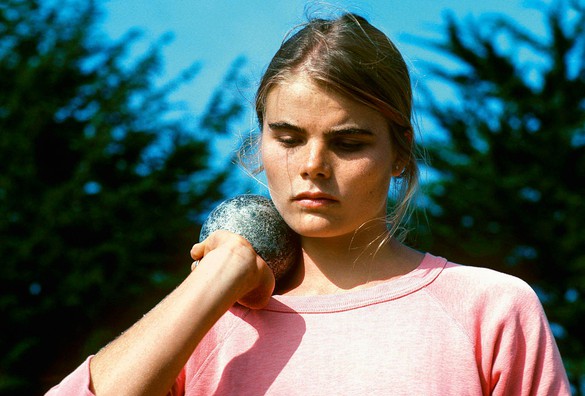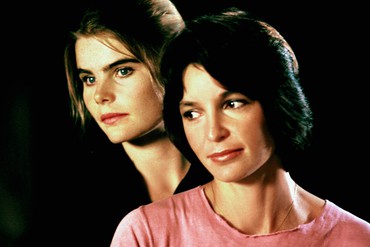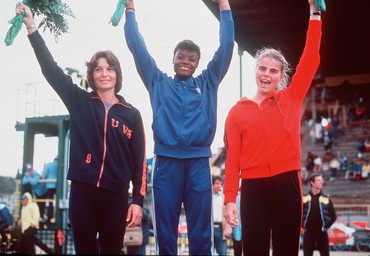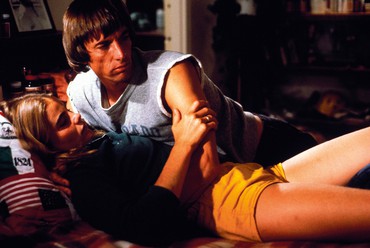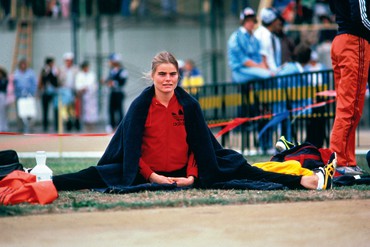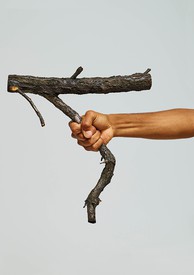
Fiona Duncan is a Canadian-American author and organizer and the founder of the social literary practice Hard to Read. Duncan’s debut novel, Exquisite Mariposa (Soft Skull Press), won a 2020 Lambda Award. She is currently developing a narrative biography and critical study of the transdisciplinary American artist Pippa Garner.
In the April 1982 issue of Playboy, Robert Towne, the Academy Award–winning screenwriter of Chinatown (1974), likened being a writer to being a woman, “because women tend to have more power and more acumen than they’re generally credited with,” he said. “The same with a screenwriter. Everybody concedes you’re important, but the political leverage has never been consonant with the contribution. I’ve always felt that about women.”
Towne was being interviewed about his directorial debut, Personal Best, a movie that would be declared a flop, earning just over a third of its total $16 million budget at the box office. “Personal Best opened in 1982 and immediately disappeared,” wrote Peter Biskind in his often referenced account of the New Hollywood wave of ’70s American cinema, Easy Riders, Raging Bulls: How the Sex-Drugs-and-Rock ’n’ Roll Generation Saved Hollywood (1998). Mimicking European cinema, New Hollywood was auteur driven; it turned directors into stars. Towne was one of the movement’s few big-name writers, having worked on many lucrative pictures: as a script doctor on Bonnie and Clyde (1967) and The Godfather (1972), and as the author of The Last Detail (1973), Shampoo (1975), and, of course, Chinatown, still considered one of the greatest screenplays of all time. But the first film Towne directed, which he also wrote and produced, was dismissed as a failure in Biskind’s narrative, as it would be in most literature on this moment in film history. And save for references in a handful of queer-cinema anthologies, Personal Best did almost disappear.
In his original screenplay for Chinatown, Towne had his female lead—the Faye Dunaway character, Evelyn Mulwray—kill her father, Noah Cross, a corrupt business tycoon and landowner who had raped and impregnated her at fifteen. Director Roman Polanski, whose pregnant wife, Sharon Tate, had been murdered by members of the Manson Family a few years prior, demanded a rewrite: Evelyn’s shot would miss; she would drive off and be shot in the head by police instead. And Cross would get away with everything: both his latest capitalist scheme—an environmental rape—and his history of incestual rape. In the film, Evelyn’s face is shown blown open, no longer able to speak the truth she’d hidden from her daughter/sister, whom we last see screaming under the grasp of her father/grandfather, the richest man in Los Angeles, played by Hollywood patriarch John Huston, in whose monstrously large hands the girl is carried away. In New Hollywood, directors had more clout than writers and Polanski’s unforgettable, cynical finale won out, canonizing Chinatown as a gritty tragedy rather than assigning it to the fantasy genre of the rape revenge film. Was this when Towne learned that writers are like women? Silenced in the end.
If Towne wanted his words honored, he realized he had to direct them himself. His first intention was to make a movie about a boy raised by apes but he couldn’t finish writing it. A studied procrastinator, he became distracted by a new idea. A first draft materialized fast.
Personal Best is the story of two female athletes: Chris Cahill, a half–Native American hurdler who chokes in competition, and Tory Skinner, a more experienced pentathlete who takes note of Cahill’s raw talent and overall allure. Skinner is the one to first kiss Cahill. Before she does so, she says, “I’m very scared right now,” but Cahill is receptive and within the first twenty minutes of the two-hour film we get the first and only love scene between them—one of Personal Best’s many reversals of the usual order of things. Cahill and Skinner will continue to, in the latter’s words, “fuck sometimes,” but we don’t see that. What we’re shown is Skinner’s devotion to Cahill and Cahill’s stated need for this love and mentorship. Skinner believes that Cahill could be great, an Olympian like her, if only Cahill could trust her gifts and get on with it.
Personal Best was rumored to have been inspired by a news story about a male coach who had an affair with one of his female athletes. Although Towne never confirmed this, as a director he behaved much like his coach character, Terry Tingloff (played by a sinewy Scott Glenn), even going so far as to initiate consecutive affairs with the actors who played Skinner and Cahill: Patrice Donnelly and Mariel Hemingway.
When Towne cast Hemingway, in 1979, Woody Allen’s Manhattan was still in theaters. In that film, Hemingway played Allen’s girlfriend, seventeen to his forty-two. In real life, she was sixteen and a virgin who didn’t understand much of the script’s sexual innuendo. Like Brooke Shields, Hemingway looked prematurely adult. Both actors were famous by preadolescence for playing, respectively, a rape victim (Hemingway in Lipstick, 1976) and a sex worker (Shields in Pretty Baby, 1978), and both grew to be tall, grazing either side of six feet; with bushy eyebrows and brawny jaws, they were doppelgänger juveniles. Eighteen when she petitioned for the role of Cahill, Hemingway trained for twelve months on and off (a span broken by an actors’ strike) to play a convincing athlete alongside Donnelly and the rest of the cast, most of whom were top real-life athletes—in fact Donnelly was a former Olympian. Hemingway learned to hurdle and race. She trained everything but her signature voice, which remained childish and was likened by journalists to that of Mickey Mouse.
“I’m sorry, Daddy,” are the first words we hear Hemingway squeak in Personal Best. It’s 1976 and she, or rather Cahill, has just lost another race. Trained by her white father, whose coaching techniques include guilt, shame, and belittlement, Cahill has learned to falter under pressure. When the guns marking “go” are fired, she literally flops, falling far behind her competitors, even falling on her face. Personal Best is about personal development: how does one become the best version of oneself in a given sport (or art)? What motivates excellence?
The patriarchal paradigm is depicted as a dead end in Towne’s film. A father who coaches his kin to reaffirm his own excellence produces an athlete whose failures can be read as an unconscious rebellion against him. (Towne admittedly had daddy issues.) Skinner rescues and mentors the younger athlete, eventually convincing her own coach, Tingloff, to train Cahill as well. Suggestive dialogue and eye contact give the impression that there’s a history of intimacy between Skinner and her coach; clocked by Cahill, this unspoken erotic tension will contribute to her growth. The viewer is left to project whether there’s jealousy involved or whether Cahill simply wants to belong with Skinner, Tingloff, and/or the intimacy they share, which may be what Cahill desires: an intimacy with track and field. That’s not her only motivator, though: in addition to this ambiguously articulated mimetic desire, Cahill gets maternal reassurance, sexual confidence, and objectively good training from Skinner. And from the extended team of exceptional women she trains alongside—collectively, the true stars of the film—she receives peer-to-peer encouragement, girl-gang belonging.
Cahill also endures, in an act of fate or chance, a knee injury that breaks both her and Skinner’s hearts. This comes through a Shakespearean misunderstanding akin to the misplaced letters in Romeo and Juliet and King Lear. But unlike those tragedies, Personal Best doesn’t make its heroines die ignorant of the tragic irony that led them to their demise; one of them is merely injured, and, with access to quality physical therapy, rehabilitates, stronger and wiser than ever, and right in time for the 1980 Olympics qualifying match. There she settles the score with her “manipulating sadistic creep” of a coach by sacrificing, in a stunning final race, her lead so that Skinner, by that point her ex, can win the event and place in the top three overall alongside her. That’s when dramatic irony really drops: in the film as in real life, the United States boycotted the 1980 Olympics, which were in Moscow, to protest the ongoing Soviet-Afghan war. No Americans competed that year. As an announcer in the film broadcasts, “They’re all dressed up”—cut to three athletes sweating in tank tops—“with nowhere to go.”
Towne’s gift, when he was allowed to exercise it, was scripting melodramas that reveal themselves in a rewatch. Embedded in historical contexts, his sequences of cause and effect are lifelike, with monumental changes accruing through obscure little gestures and twists such that it’s only in retrospect that you can piece together something of what happened; the immediate action is so immersive that were it not filmed by a multicamera setup—or, as in life, by one’s unconscious, and by other people, and revealed through talk—you might never get to know the brilliant logic of life. Many reviewers of Personal Best missed its understated moments. Overwhelmed by lesbianism, which is far from the main action of the film, the press were titillated to distraction—or were trying to sell their publications with sex. Men described steam room scenes. Feminists did as well, flagging “the male gaze.” Gays debated whether the film was gay enough; it’s calmly bisexual in a way that only Gen Z may be as a cohort ready for, though they’ll need a trigger warning for the racist and homophobic jokes that serve as the film’s set dressing.
A majority of reviewers miscommunicated the plot, asserting that Personal Best was about two lovers competing with each other in a zero-sum game. Track and field can be considered as such—there is only one gold medal for each event—but the film undoes the importance of this. What Personal Best’s characters are competing against is competition itself, and how meaning can be found beyond its strict limits. Coach Tingloff suggests that sport is a history of violence: “Look around you,” he says at the Olympic qualifying match. “Now imagine how many bodies you all buried to get here. The games—javelin, discus, shot—weapons, war, hate. You’re here because you want to kick asses and kill anybody who gets in your way.” But Personal Best rebuts him: love wins. (Love between women; love between equals, male, female, or other; love of the game; love of change.) And it communicates this without resorting to cliché, as the New Yorker film critic Pauline Kael noted: “most of the story is told non-verbally, and character is revealed in movement. This is perhaps the first directing debut by a writer that buries motivation and minimizes the importance of words.”
When asked about my favorite films, I always mention Personal Best first. I do so because I love it and because my love for it reveals a great deal about me, including how I’m a sucker for an underdog; almost no one has heard of this movie. In a conversation with Alissa Bennett, a contemporary historian known for her rereadings of notoriously misunderstood women, Patrik Sandberg suggested that “a big part of fandom is the feeling that you understand someone better than everyone else does.” And, I would add, you feel understood by them in turn. There are few characters I’ve felt more synchronous with than Chris Cahill, who was raised, as I was, by intense parents who disciplined me in a historically masculine family tradition—thinking and writing, rather than track and field—that I fitfully struggled with until I found women to learn alongside and compare myself to, women who ultimately inspired me to strive within my own personal style and values. I’ve also been a Tory Skinner: a martyr in love with a younger mentee who used me for her own self-actualization before leaving me, as Cahill will, for a boy she could tower over. How did Towne know these secrets of ambitious girl world?
Towne himself has suggested that his inferiority complex as a writer in an industry dominated by directors, actors, and producers led him to identify with women, making possible his directorial debut, with its multiple truthful, strong female characters. In the same 1982 Playboy interview, though, he also claimed that directing is, at its best, also “a woman’s game,” comparable to . . . making love with a woman? “You permit an actor to act the way you permit a woman to come,” he explained. “You don’t make it a big deal, do you? You allow. You create a very passive climate to allow it. I think directing is a woman’s game, a curiously passive process. You sit there as you watch the actors and you feel, then you tell yourself what you feel and then you tell the actors. You watch and encourage. I find it, ideally, more maternal than paternal. Make me come, make me feel good. Am I going to be in love with you after this?”
A generous read of that convoluted statement is that Towne is a trans-femme lesbian service top. (Indeed, when I asked a close friend—ten years my junior, nonbinary, and queer—to watch Personal Best, they replied afterward that it seemed “T4T low key.”) A less fun interpretation is that Towne held contradictory self-serving identifications: a talented writer, an originator, the one who first delivers usable material (in an industry where that role, perhaps because of its necessity—or its perceived passivity—is grossly diminished), who also suffered from chronic illness (which his male peers suggested came from neurosis), he was clearly capable of radical empathy; his characters speak to this. But he was also a grown man with daddy issues surrounded by cocky men like his actor, director, and producer friends Warren Beatty, Jack Nicholson, and Robert Evans. As soon as Towne stepped into a like role, he started behaving like the despicable men of Hollywood: berating and bedding actresses half his age, abusing cocaine and his wife, failing to communicate with his crew, then blaming them. Screaming often. He protracted the film’s production, running the budget way up. He pissed off his producers; sued, he countersued. He almost lost the picture. And he contributed to its failure: not only was Personal Best too expensive for a niche narrative—it never earned its keep, and thus was relegated, in the minds of Hollywood’s reigning men, to the “flop” pile, where it would “disappear” from critical regard—the film also awkwardly straddled decades and audiences.
Initiated in 1979 and set between 1976 and 1980 but not released until 1982, Personal Best was neither glossy nor high octane enough for the movie mainstream from the ’80s on, nor was it violently patriarchal enough for Old Hollywood, New Hollywood, or Hollywood to this day. Ambiguous, character driven, casual about sex (or trying to be, as best as Americans can manage), and cerebral (again by American standards), with that murky ’70s grain, Personal Best is most like a New Hollywood picture—except that the most successful films of that movement tended to be (like Easy Rider, Chinatown, Taxi Driver, The Godfather, and Apocalypse Now) as macho as Mariel Hemingway’s grandfather, Ernest, sought to be. (Without talking to Towne or Hemingway, it’s impossible to say much other than that it’s notable that a man who felt feminized as a writer cast an actress descended from the butchest writer in twentieth-century American history.) During the film’s press push, much was made of Personal Best’s erotics. Case in point: Mariel Hemingway on the cover of Playboy, in the same April 1982 issue as Towne’s interview. Her nude double-page spread—she’s doing the splits—is accompanied by a short profile in which she’s quoted sparingly. Towne’s Q&A is four times as long. Sex can sell but the sex in Personal Best was too sweet to top the box office. Cahill is like a Hayao Miyazaki heroine, an innocent on a journey of becoming, with her innocence extending to a bisexuality that is never abject, violent, victimized, or shame ridden, as Hollywood relies on, with regard to femmes, to capitalize on attention.
Movies are collective endeavors. That’s what Towne learned in trying to become an auteur.
“I had final cut and I was the writer and, out of necessity, became the producer and director,” he said of Personal Best to the editors of Projections 6: Film-makers on Film-making (1996), and “that moment when you theoretically have control is the moment when you realize that you have no control. Anything can happen.” Of course a good writer wouldn’t claim authority over a process as lively as movie-making; only those insensitive to human social dynamics would. Towne worked with five editors, two costume designers, and three cinematographers, using Leni Riefenstahl’s Olympia (1938), on the 1936 Olympics in Berlin, as a reference, to capture performers Mariel Hemingway; Patrice Donnelly, once ranked the fourth-best hurdler in the world; pro wrestler Emily Dole; high jumper Pam Spencer; Jane Frederick, a world-record-setting heptathlete; and Jodi Anderson, a long jumper and pentathlete who was poised to crush the Olympics in 1980, the year in which she set multiple lifetime “personal bests”—that is, her highest scores and fastest times in a given event. After Towne had gone gaga seeing real-life female athletes work out at the UCLA gym, they inspired him to script Personal Best; and as a cast, they steal the show. It is their movie as much as it is his, a movie made by Anderson’s gap-tooth grin and muscle definition (she should’ve had more lines); by Donnelly’s graceful stag leaps; by the group’s camaraderie; and by two parallel breath-filled races, one shot on a sandy hill from a downward angle so the athletes appear to be running up to nowhere, the other round and round a track during the qualifying match for the canceled Olympics.
To root for an underdog is to measure greatness on a curve where adversity is a big part of the equation. One person’s flop is another’s feat. Rather than needing something to be a mainstream windfall, you’re in awe that it got made at all. By my metrics, Personal Best is one of the most important films in Hollywood history, being the first and last to depict the dynamics it does. And because it serves as a meta narrative for its own creation and how Hollywood functions.
Robert Towne is to Personal Best what Coach Tingloff is to his trainees: the male pseudo-authority and the saboteur whose simultaneous elevation and degradation of the women under his charge, his identifying with them and lusting after them, precipitates his own irrelevance. The last time we see Tingloff it’s via Cahill’s gaze. She’s about to mount the winner’s podium and gives him a dead stare. His projected insecurities as a man coaching women (female athletes, he notes, are less important than their male counterparts) risked ruining Skinner’s and Cahill’s relationship, just as, I’m sure, Towne’s lurid, Stanley Kubrick–meets–Peter Bogdanovich control tactics to get “the best” out of his actresses weren’t healthy for anyone involved. Tingloff is shady and Towne knows it. He puts him in black aviator sunglasses when Cahill walks away from him to her podium.
Personal Best put Towne in the Hollywood doghouse. After its financial failure, he would struggle to recover power in an industry that privileges profit over art, men over women, and spectacle over story. The working conditions for writers of caliber would only get worse, as is evidenced by the 2023 Writers Guild of America strike, ongoing as I write. The inequitable deals that Towne complained about forty years ago seem like pipe dreams compared with the pittance that screenwriters are protesting now, and that’s saying nothing of what it’s like for poets, novelists, journalists, and essayists whose best shot at a substantial paycheck is to have their material adapted for the screen. Writers are treated like women have been: with our essential labor tantamount to a volunteer position, at once invisible in a superficial culture and naturalized (anyone can do this, right? we do it because we love it, right?), writers are rarely invested in and celebrated for their own sake these days; we are used rather to support others—to prop up visual artists’ worth and supply the skeletons upon which flimsy films are laid. Towne admired novelists back in the twentieth century, when many did. He settled for screenwriting, and yet, when it was time to rise above that station—by directing—he turned the social ladder he was climbing into a snake. One wonders if his downslide was not deliberate, similar to Cahill’s foundering when her father coached her. Did Towne martyr himself? Was Personal Best his rebellion against greed, inanity, and male supremacy? In his film’s end, the women win a place in the Olympics, but the games are canceled; Towne made a masterpiece that was destined to flop at the box office. As if he knew the rigged game he was playing, the moral of his movie is that winning is fleeting and the best you can ever do, as Cahill’s boyfriend—a young, retired, former gold-medal winner—tells her, “is whip your own ass.”
